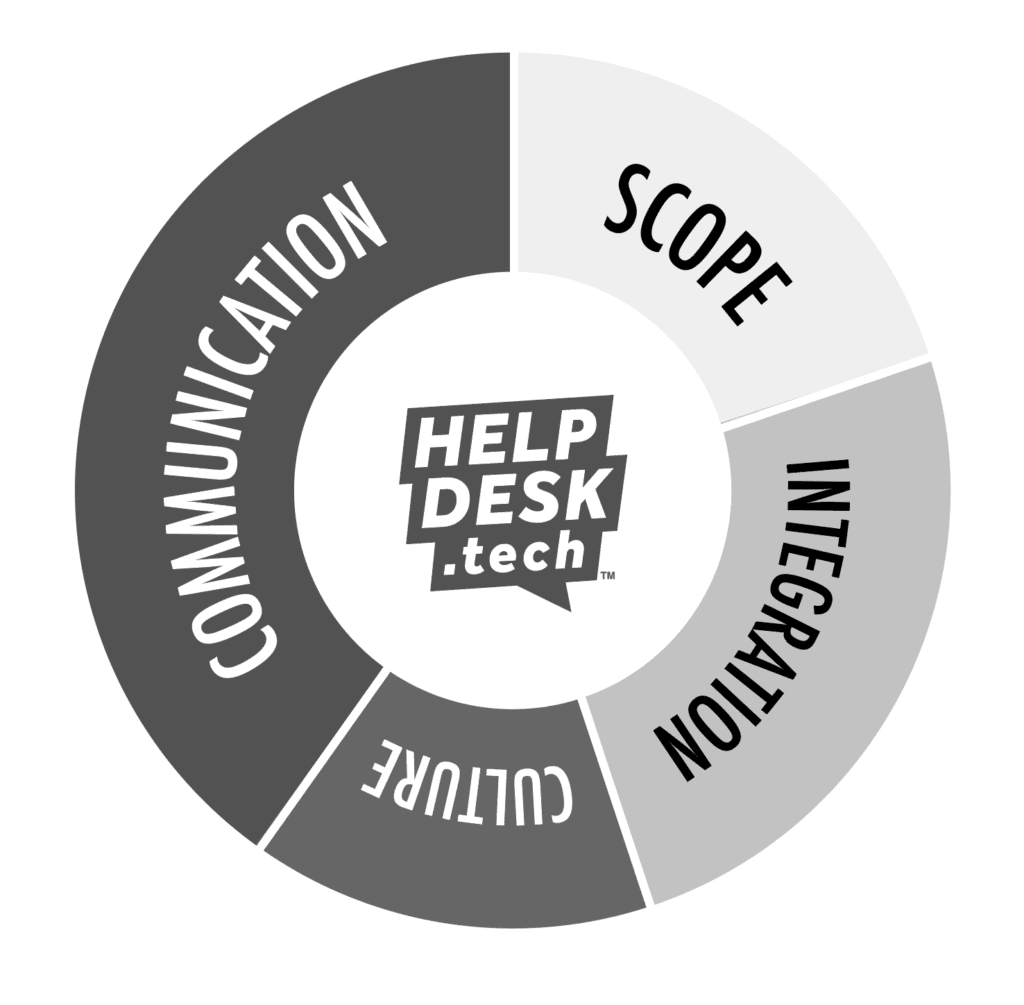- Competent, Friendly, Nationwide
Co-managed IT is an innovative and collaborative approach in which an organization’s internal IT team partners with an external managed service provider (MSP). This model is particularly valuable for large enterprises, offering the best of both worlds: the internal team’s deep understanding of the organizationʼs unique needs and culture, and the MSP’s specialized expertise, scalability, and broad experience across industries. Among the many areas where co-management excels, the help desk stands out as a critical application. As the primary interface between users and IT services, the help desk’s performance directly impacts user satisfaction, productivity, and the overall effectiveness of IT operations.
Enterprises often face challenges such as managing high ticket volumes, addressing complex troubleshooting needs, and meeting the demand for 24/7 support. A co-managed help desk provides a hybrid solution, seamlessly blending the resources and capabilities of both the internal team and the MSP. This approach delivers the flexibility, scalability, and round-the-clock service coverage required to navigate todays dynamic and demanding IT environment. Through this exploration, we will dive into the benefits of co-managed help desks, discuss strategies for successful implementation, and highlight best practices. Additionally, we will examine collaboration models, the integration of advanced technology, and the essential role of communication and documentation. By understanding these key components, enterprises can unlock the full potential of a co-managed help desk, driving efficiency and user satisfaction to new heights.
The co-managed help desk model offers a scalable and adaptive solution to meet the fluctuating demands of modern enterprises. By collaborating with an MSP, organizations can expand their support capabilities without overextending their internal teams. This partnership introduces specialized skill sets and industry expertise that enhance the resolution of technical issues, ultimately improving system reliability and minimizing downtime. Furthermore, co-managed models optimize resource allocation, making them more cost-effective compared to fully in-house or outsourced alternatives.
A significant advantage of co-managed help desks is the ability to provide continuous support. The inclusion of 24/7 operations ensures that user issues are addressed promptly, regardless of the time of day or geographic location. This uninterrupted
service fosters a sense of reliability and professionalism, enhancing user satisfaction and promoting trust in IT operations. Faster response and resolution times not only improve the overall user experience but also contribute to higher productivity and morale across the organization. By addressing technical challenges efficiently, employees can focus on their core responsibilities without unnecessary interruptions.
While the benefits of co-managed help desks are compelling, enterprises must navigate several challenges to maximize their potential. One of the most significant hurdles is the integration of tools, workflows, and processes between the internal IT team and the MSP. Achieving a seamless integration requires thoughtful planning, mutual understanding, and the selection of compatible technologies. Equally important is the alignment of objectives and key performance indicators (KPIs). Establishing shared goals ensures consistency in service quality and facilitates accurate performance evaluation.
Effective communication is another cornerstone of successful co-managed help desks. Without clear communication protocols, misunderstandings can lead to delays or inconsistent service delivery. Proactively establishing structured communication channels helps mitigate these risks and fosters a collaborative relationship. By addressing these challenges with strategic planning and a focus on transparency, enterprises can build a co-managed help desk that is both resilient and efficient, delivering consistent value to users.
To further enhance the effectiveness of co-managed IT help desks, organizations must also address the cultural and operational differences between their internal IT teams and the managed service provider (MSP). Internal teams may have established practices, priorities, and expectations that differ significantly from those of the MSP. Bridging this gap requires fostering a culture of collaboration, where both parties view each other as partners rather than separate entities. Regular team-building activities, shared training sessions, and collaborative problem-solving initiatives can help build trust and ensure alignment in approach.
Another critical consideration is the delineation of roles and responsibilities. In co-managed setups, overlapping duties or unclear boundaries can result in inefficiencies, duplication of effort, or overlooked tasks. Clearly defining who handles what—whether it’s user support tickets, network maintenance, or incident escalation—prevents confusion and ensures that both teams operate in harmony. Creating and regularly revisiting a detailed responsibility matrix can help maintain clarity and adaptability as business needs evolve. By proactively addressing these deeper challenges, enterprises can unlock the full potential of their co-managed IT help desk model, turning it into a strategic advantage.

Committing to solutions and realistically setting your own expectations as you navigate the challenges can help you maximize your opportunity with co-management.
Key ticketing and other ITSM software integrations can make all the difference in ensuring your internal team and your co-managed team stay on the same page and act as one.
Successful co-management relies on a foundation of open and transparent communication. Establishing clear protocols for information sharing and collaboration ensures that all stakeholders remain aligned and informed.
Regular feedback loops from team members and end-users offer valuable insights into the strengths and weaknesses of the co-managed help desk. Comprehensive documentation of processes, configurations, and resolutions minimizes the risk of miscommunication and accelerates onboarding for new team members. Finally, leveraging data analytics provides actionable insights into workflow optimization and future challenges.
Evaluating the performance of a co-managed help desk involves analyzing key metrics that reflect its efficiency and effectiveness. Response times, resolution rates, and first-contact resolution percentages are critical indicators of service quality. Monitoring customer satisfaction scores provides direct feedback on the user experience, while tracking the volume of unresolved tickets highlights areas requiring additional focus.
Financial metrics, such as cost savings achieved through the co-managed model, further demonstrate the value of this approach. By continuously assessing these metrics, enterprises can identify trends, address bottlenecks, and refine their strategies.
For enterprises seeking an exceptional co-managed help desk solution, HelpDesk.tech offers a compelling partnership. Our services are tailored to seamlessly integrate with an organizationʼs internal IT team, functioning as an extension of enterprise staff while maintaining the organizationʼs identity through white-label services. This approach ensures that end-users experience consistent and professional support branded under your enterpriseʼs name.
One of the standout features of HelpDesk.tech is our ability to minimize escalations. Our experienced Level 1 technicians are skilled in resolving a broad spectrum of end-user issues efficiently, reducing the need for internal IT staff to handle routine or repetitive tasks. This allows the enterpriseʼs internal team to focus on strategic projects and initiatives without frequent interruptions, leading to better overall productivity.
Flexibility is a hallmark of HelpDesk.techʼs offerings. We adapt our scope to meet the specific needs and preferences of each organization, whether it involves taking full ownership of certain issues or collaborating closely with internal teams. Adaptability ensures alignment with the enterpriseʼs operational workflows and security protocols, fostering a harmonious partnership.
Additionally, HelpDesk.tech provides scalable and pricing models designed to accommodate the dynamic needs of large organizations. Our pricing structureʼs flexibility is particularly valuable for organizations seeking a tailored solution that evolves alongside their needs, scaling accordingly along predictable guidelines.
By choosing HelpDesk.tech as your co-managed help desk partner, enterprises like yours gain access to a highly skilled team of professionals, improved response times, and enhanced operational efficiency. With our ability to seamlessly integrate into existing IT environments and deliver measurable results, HelpDesk.tech stands out as an ideal partner for enterprises looking to optimize their IT support capabilities.
Let us show you how our co-managed model can enhance your operations, reduce costs, and improve employee satisfaction. Reach out to info@helpdesk.tech to start the discussion and learn more about how we can transform your end-user support and help your enterprise thrive.

We make IT easy and affordable.
7815 North Palm Avenue, Suite 200
Fresno, California 93711

That's worth a discussion, right?
Sign up below to learn more.